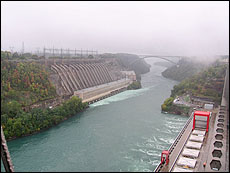Archives
Book details history of Niagara hydroelectricity
By PATRICIA DONOVAN
Contributing Editor
Landscape architect Lynda Schneekloth, professor of architecture in the School of Architecture and Planning, is delighted that “The Power Trail: History of Hydroelectricity at Niagara,” which she wrote with three of her former students, has received the Merit Award of Achievement from the New York state upstate chapter of the American Society of Landscape Architects.

The two Adam Beck power plants on
the Canadian side of the Niagara River (left), along with the Robert
Moses Power Plant on the U.S. side, create a concrete walled gorge at
the Lewiston-Queenston bridge crossing.
PHOTO: ANA
HERNANDEZ-BALZAC
This first-of-its-kind book was published in September 2006 by Western New York Wares. Its authors, including Brett Gawronski (M.Arch. ’05, B.S. ’03), Thomas Yots (M.Arch. ’02) and Jana Kasikova (M.Arch. ’05, B.S. ’03), offer an excellent education on the unique character of the Niagara region and the history of one of its principal topographical elements at a crucial time in American industrial development.
The book will be part of an exhibition of recent work on Buffalo Niagara industrial heritage being held from 5-7 p.m. Feb. 15 in the lobby of Hayes Hall, South Campus. The event will feature a book signing, as well as a display of photos from the book.
“The Power Trail” is the dramatic story of how great minds of science and industry harnessed the mighty Niagara River to produce electricity, which, despite our incredible reliance upon it, has been with us for little more than 100 years.
Besides showcasing the impressive power plants they call “temples to the Industrial Revolution,” the authors explore the innovations, conflicts and tragedies that arose from the struggle between those with visions of the endless generation of power and those who sought to preserve the landscape of Niagara Falls.
Schneekloth points out that some industrialists of the period argued for a complete halt to water flowing over the falls. For example, Lord Kelvin, who in 1893 headed an international commission on design of the Niagara Falls power station, said he hoped his grandchildren would never see the flow of water over the falls. They didn’t win out entirely, but today, the authors remind us, as much as 75 percent of the river’s water is withdrawn for power production before it even reaches the falls—enough to give every American a glass of water every 12 seconds.
“Many colorful characters played key roles in the unfolding drama,” she says, “and we profiled them as well.”
Among them are battling entrepreneurial rivals Thomas Edison and George Westinghouse; Serbian inventor, physicist, mechanical engineer and electrical engineer Nicola Tesla; Jacob Schoellkopf, the “King of Electricity,” whose Niagara Falls Hydraulic Power & Manufacturing Co. was the first to produce electricity using Niagara Falls; and the chiefs of the Tuscarora Nation, from which was expropriated 550 acres of land for use as a storage reservoir for a hydroelectric power project and whose subsequent lawsuit was decided by the U.S. Supreme Court.
In text and 250 photographs, many never published before, the authors recount many milestone events related to the hydroelectric revolution, including the horrifying collapse of the Schoellkopf Power Plant on the American side of the river in 1956. A contemporary newspaper account describes the destruction:
“The roar was awesome. It looked as if the whole gorge wall had opened up like the side of a skyscraper, and down it came. Rocks and masonry burst into the air splitting into thousands of pieces and pelted the river like shrapnel. And a few fell on the Canadian side. A jet stream of water was unleashed. Three violent blasts followed. The river turned a sickly brown. White smoke poured upward from the gaping gorge mouth and the resounding echo died.”
Thirty-nine workers escaped, but one was killed in the collapse.
“The book is an attempt to bring to the general public the illumination and excitement we experienced as we uncovered the extraordinary history of hydroelectricity at Niagara Falls embedded in the story of people, buildings and ruins,” Schneekloth says.
“Alongside the past and present celebration of the technological achievement of power are the efforts of a series of ‘Free Niagara’ movements to conserve one of the most beautiful places on earth, Niagara Falls.”
She points out that the first phase of the movements originated with such notables as Hudson River school artist Frederic Edwin Church, landscape designer Frederick Law Olmsted and architect Henry Hobson Richardson. Their work, plus exhaustive efforts by many other preservationists of the late 19th century, finally led to the 1885 establishment of the Niagara Reservation, New York’s first state park.
Her education on the history of hydroelectricity at Niagara, Schneekloth says, was a crash course received during the Niagara Power Project relicensing effort in 2003-06, for which she served as a representative of Buffalo Niagara Riverkeeper, negotiating on behalf of the Niagara River.
The book itself, she says, had its origins in the substantial research produced in a design studio called “The Power Trail,” which she taught in fall 2003. Students in that studio, including two of the co-authors, prepared historic documentation on the various power plants, followed by proposals for how this history might be made more visible to the residents and visitors to Niagara Falls, New York and Canada.
Schneekloth, also the landscape director of the UB Urban Design Project in the School of Architecture and Planning, is the author of “Placemaking: The Art and Practice of Building Communities” (1995 with Robert Shibley), “Ordering Space: Types in Architecture and Design” (1994 with Karen Franck), “Changing Places: ReMaking Institutional Buildings” (1992 with Barbara Campagna and Marcia Feuerstein) and, most recently, “Reconsidering Concrete Atlantis: Buffalo Grain Elevators” (2007), which will be part of the Feb. 15 exhibition in Hayes Hall.
